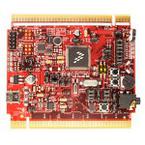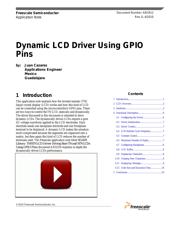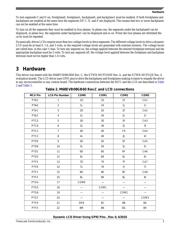herunterladen

1 Introduction
This application note explains how the twisted nematic (TN)
liquid crystal display (LCD) works and how this kind of LCD
can be controlled using the microcontroller's GPIO pins. There
are two ways to control the TN LCD, statically and dynamically.
The driver discussed in this document is intended to drive
dynamic LCDs. The dynamically driven LCDs require a pure
AC voltage waveform applied to the LCD electrodes. Each
electrode needs one backplane electrode and one frontplane
terminal to be displayed. A dynamic LCD makes the situation
more complicated because the segments are organized into a
matrix, but then again this kind of LCD reduces the number of
terminals used. The Freescale application note titled XGATE
Library: TN/STN LCD Driver Driving Bare TN and STN LCDs
Using GPIO Pins (document AN3219) explains in depth the
dynamically driven LCDs performance.
© 2010 Freescale Semiconductor, Inc.
Document Number: AN3412
Freescale Semiconductor
Rev. 0, 4/2010
Application Note
Dynamic LCD Driver Using GPIO
Pins
Juan Cazaresby:
Applications Engineer
Mexico
Guadalajara
Contents
Introduction...........................................................11
LCD Overview......................................................22
Hardware ..............................................................33
Functional Description..........................................64
Configuring the Driver..................................64.1
Driver Initialization.......................................74.2
Driver Control...............................................74.3
LCD Refresh Cycle Frequency.....................74.4
Contrast Control............................................74.5
Maximum Number of Digits.........................74.6
Configuring Backplanes................................84.7
LCD Buffer...................................................84.8
Displaying Characters...................................84.9
Creating New Characters..............................94.10
Displaying Message......................................94.11
Code Size and Execution Time...................104.12
Conclusion...........................................................105
Verzeichnis








